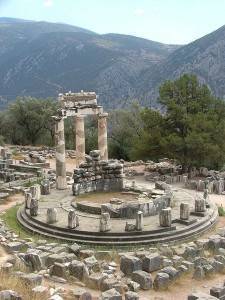Acropolis
5th-century B.C. hilltop temple monument
The Acropolis of Athens is an ancient citadel located on an extremely rocky outcrop above the city of Athens and contains the remains of several ancient
The Acropolis of Athens is an ancient citadel located on an extremely rocky outcrop above the city of Athens and contains the remains of several ancient buildings of great architectural and historic.
Parthenon
Iconic 5th BC Athenian temple ruins
The Acropolis of Athens is an ancient citadel located on an extremely rocky outcrop above the city of Athens and contains the remains of several ancient buildings of great architectural and historic significance, the most famous being the Parthenon.
See all the Athen sights
Three Bells of Fira
Much-photographed church known for its blue dome, whitewashed walls & views of the Aegean below.
Akrotiri
Akrotiri (Greek: Ακρωτήρι, pronounced Greek: [akroˈtiri]) is a Minoan Bronze Age settlement on the volcanic Greekisland of Santorini (Thera). The settlement was destroyed in the Theran eruption about 1627 BC and buried in volcanic ash, which preserved the remains of fine frescoes and many objects and artworks. The settlement has been suggested as a possible inspiration for Plato's story of Atlantis. The site has been excavated since 1967.
See all Santorini sights
Palace of the Grand Master of the Knights of Rhodes
The Palace of the Grand Master of the Knights of Rhodes, also known as the Kastello, is a medieval castle in the city of Rhodes, on the island of Rhodes in Greece. It is one of the few examples of Gothic architecture in Greece
Akropolis von Lindos
Ruins, château, and castle
See all Rhodes sights
Achilleion
1800s palace, museum & gardens
19th-century neoclassical mansion featuring Achilles-themed interiors & gardens with sea views.
Angelokastro
Hilltop castle with art & water views
Ancient castle at the top of a steep hill with art, historical exhibits & dramatic ocean views.
See all Corfu Island sights
Temple of Apollo
The Temple of Apollo in Delphi was first built around the 7th century BC and was rebuilt a few times due to fire and earthquake. The temple survived until AD 390, when the Roman emperor Theodosius I destroyed the temple and most of the statues and works of art in the name of Christianity. The temple housed the Oracle of Delphi who would provide answers or prophecies to those who visited on the seventh day of each month. The Oracle would breathe in the fumes emanating from a fissure in the earth and fall into a trance like state. This temple held significant importance in the ancient world and is a must see for anyone interested in Greek history.
See all Delphi sights

